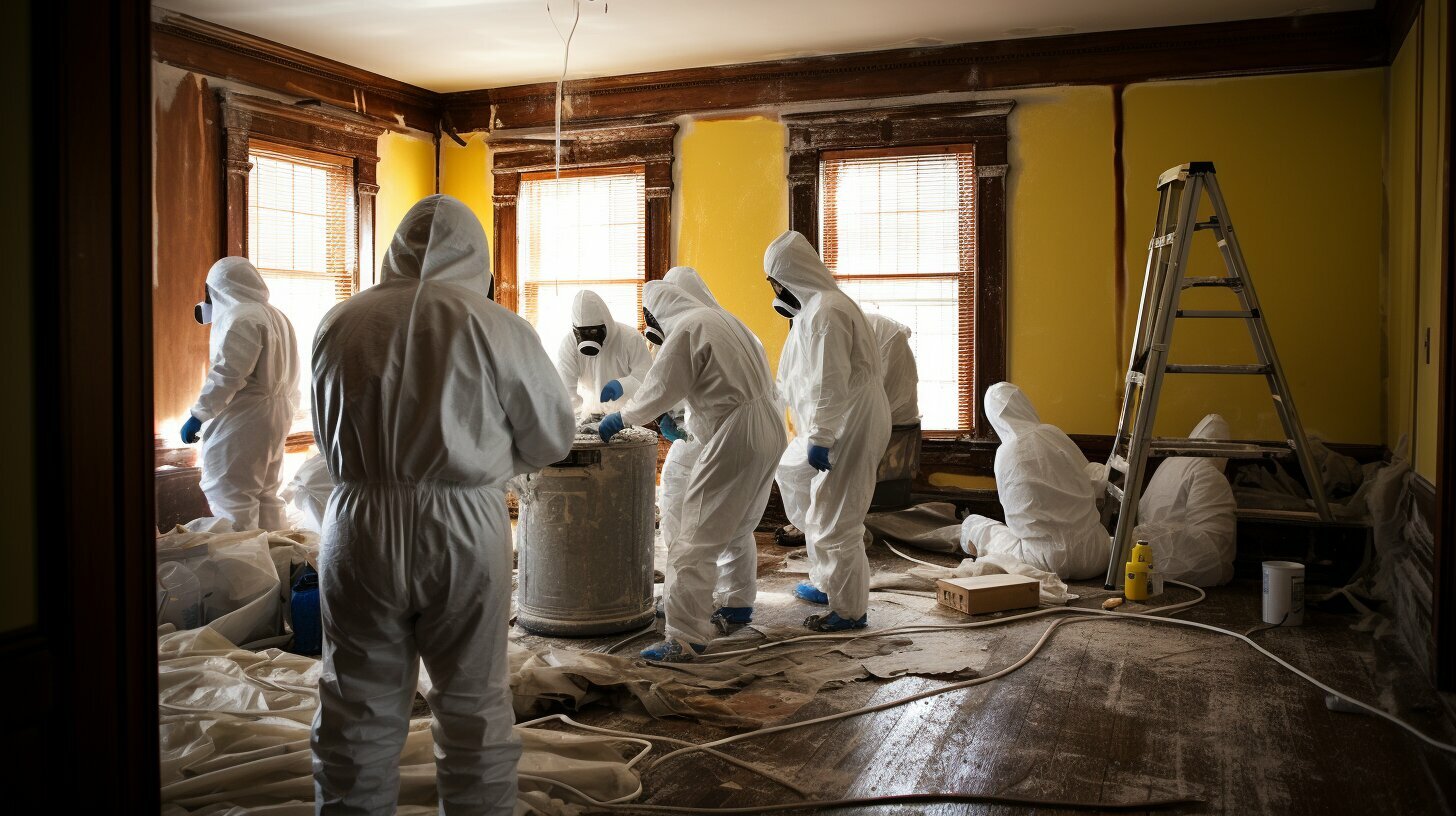If your home has suffered from water damage, you may be concerned about how long the restoration process will take. While the answer to this question depends on various factors, it's essential to have a general understanding of the
home restoration timeline.
In this section, we will explore the process of restoring a home after
water damage and the timeline that it typically takes. We will also discuss the various factors that can impact the duration of the restoration process.
Key Takeaways:
- The duration of home restoration after water damage can range from a few days to several weeks.
- The restoration process involves initial assessment, water extraction and drying, cleaning and sanitizing, repairing and restoring damaged structures, monitoring, and preventive measures.
- The extent of the damage, the type of water, and the efficiency of the restoration process can impact the time it takes to restore a home.
Understanding the Water Damage Restoration Process
When water damage occurs in your home, restoring it to its former state can be a daunting task. It’s important to understand the water damage restoration process so you can estimate how long it will take to restore your home to its pre-damage condition.
The process begins with an initial assessment of the damage. A
professional restoration company will inspect the affected areas and identify the extent of the damage. This stage is crucial in estimating the duration of the restoration process. The damage assessment will determine the type of water that caused the damage and the extent of the damage to materials and structures.
Once the assessment is complete, water extraction and drying become the next critical steps in the restoration process. Water extraction involves the removal of standing water using specialized equipment. The drying process follows the extraction, and a combination of fans, dehumidifiers, and heaters are used to dry out the affected areas. The speed of the drying process will depend on the amount of water, the size of the affected area, and the efficiency of the equipment used.
The next step involves cleaning and sanitizing the affected areas. This is important to remove harmful contaminants and prevent mold growth. Cleaning and sanitizing can involve disinfecting surfaces, cleaning carpets and upholstery, and deodorizing the home. Similar to the previous steps, the time required for cleaning and sanitizing will depend on the size of the area and the extent of the contamination.
With the affected areas thoroughly cleaned and dried, the focus shifts to repairing and restoring any damaged structures. This stage can involve fixing plumbing issues, replacing damaged drywall, or flooring and restoring electrical systems. The duration of this stage depends on the extent of the damage and the availability of materials and contractors.
Even after the initial restoration is complete, professionals may recommend ongoing monitoring of the restored areas to ensure there are no hidden issues. Preventive measures such as installing sump pumps, waterproofing basements, or improving drainage systems can help prevent future water damage. The duration of monitoring and preventive measures will vary based on individual circumstances.
Now that you understand the water damage restoration process, you can better estimate the duration of restoration needed to restore your home after water damage. Factors such as the extent of the damage, the type of water damage, and the efficiency of the restoration process will all impact the duration of the restoration process. Working with experienced professionals and following a structured restoration plan will ensure your home is restored efficiently and effectively.
Assessing the Extent of the Damage
When restoring a home after water damage, professionals need to first assess the extent of the damage to estimate the
time frame for water damage restoration. Factors such as the type of water, the cause of the damage, and the extent of the damage will all impact the duration of the restoration process.
During the assessment, the professionals will identify the category of water damage, which ranges from clean water to black water (sewage backup). They will also evaluate the affected areas to determine the extent of the damage and identify any structural issues that need to be addressed.
The time required to assess the damage will depend on the size of the affected area and the complexity of the damage. A thorough assessment is crucial in estimating the
water damage repair duration and ensuring that the restoration plan is tailored to the specific needs of the home.
Water Extraction and Drying
Once the initial assessment is complete, the next step in the water damage restoration process is water extraction and drying. This involves removing any standing water from your home, which can be done using specialized equipment such as pumps and vacuums.
After removing the water, the affected areas must be thoroughly dried to prevent further damage from occurring. This step typically involves using high-powered fans and dehumidifiers to remove excess moisture from the air and surfaces in your home. The duration of this stage can vary depending on the amount of water, the size of the affected area, and the efficiency of the drying equipment used.
Factors that may impact the duration of water extraction and drying include the type of water damage (clean water or contaminated water), the humidity levels in the home, and the extent of the damage. Additionally, any delays in starting the water extraction and drying process can prolong the overall restoration time.
Cleaning and Sanitizing
After the affected areas are dried out, the next step in the water damage restoration process is cleaning and sanitizing. This step is crucial to remove any remaining contaminants and prevent mold growth. Cleaning and sanitizing may involve disinfecting surfaces, cleaning carpets and upholstery, and deodorizing the home.
The duration of this stage can vary depending on the size of the affected area and the extent of the contamination. In some cases, specialized equipment such as dehumidifiers and air scrubbers may be required to ensure proper cleaning and sanitization. The efficiency of the equipment used can also affect the time required for this stage.
It is important to note that skipping or rushing the cleaning and sanitizing stage can lead to long-term damage to your home and potentially pose health risks to you and your family. Therefore, it is crucial to work with experienced professionals who will take the time to thoroughly clean and sanitize all affected areas with the necessary methods and equipment.
Factors affecting the duration of the cleaning and sanitizing stage include the size of the affected area, the extent of the contamination, and the efficiency of the equipment used.
Repairing and Restoring Damaged Structures
After the affected areas have been thoroughly cleaned and dried, the restoration process moves on to repairing and restoring any structural damage that occurred due to water damage. This could include fixing plumbing issues, replacing damaged drywall or flooring, and restoring electrical systems.
The duration of this stage depends on the extent of the damage and the availability of materials and contractors. It can take anywhere from a few days to several weeks to fully repair and restore a home after water damage.
It's important to work with experienced professionals during this stage to ensure the repairs are done efficiently and effectively. Choosing the right contractors and materials can also impact the
speed of home restoration after water damage.
Additionally, it's important to keep in mind that further inspections may be necessary after the initial repairs are done to ensure there are no underlying issues that could cause future water damage. By taking a comprehensive approach to repairing and restoring damaged structures, homeowners can help prevent future water damage and ensure their homes are fully restored to their pre-damaged state.
Monitoring and Preventive Measures
Once the restoration process is complete, it's crucial to monitor the restored areas to ensure there are no hidden issues. Professionals may recommend ongoing monitoring and maintenance to prevent future water damage. This could include regular inspections, testing for mold growth, and addressing any potential vulnerabilities in your home's plumbing or drainage systems.
Preventive measures such as installing sump pumps, waterproofing basements, and improving drainage systems can also help minimize the risk of future water damage. These measures may require additional time and investment, but they can ultimately save homeowners money and frustration in the long run.
Factors such as the extent of the damage, the efficiency of the restoration process, and the type of preventive measures implemented can all impact the duration of the repair and restoration process. By working with experienced professionals and following a structured restoration plan, you can ensure your home is fully restored and protected from future water damage.
Conclusion: Factors to Consider
When estimating the time it will take to restore your home after water damage, there are several factors to consider. The
average time to restore a flooded house can vary depending on the extent of the damage and the efficiency of the restoration process.
One of the first factors to consider is the extent of the damage. A minor water damage incident may only take a few days to restore, while a major flood that affects multiple rooms or levels of your home may take several weeks.
The efficiency of the restoration process is another key consideration. Working with experienced professionals who have the right equipment and expertise can help streamline the restoration process and minimize downtime. On the other hand, a DIY restoration attempt may take longer and even result in additional damage if not done correctly.
It's also important to note that individual circumstances can impact the duration of the restoration process. For example, if there are delays in getting materials or contractors, this can add time to the overall timeline. Additionally, if there are unexpected issues that arise during the restoration process, this can also impact the duration of the restoration.
By taking all of these factors into consideration and working with experienced professionals, you can estimate the time it will take to fully restore your home after water damage. While the process may seem overwhelming, by following a structured restoration plan and implementing preventive measures, you can ensure your home is restored efficiently and effectively.
Don't hesitate to reach out to professional water damage restoration companies to get an estimate on the timeline and cost of restoring your home. They have the expertise and equipment necessary to get the job done quickly and efficiently, so you can focus on getting back to your normal life.





